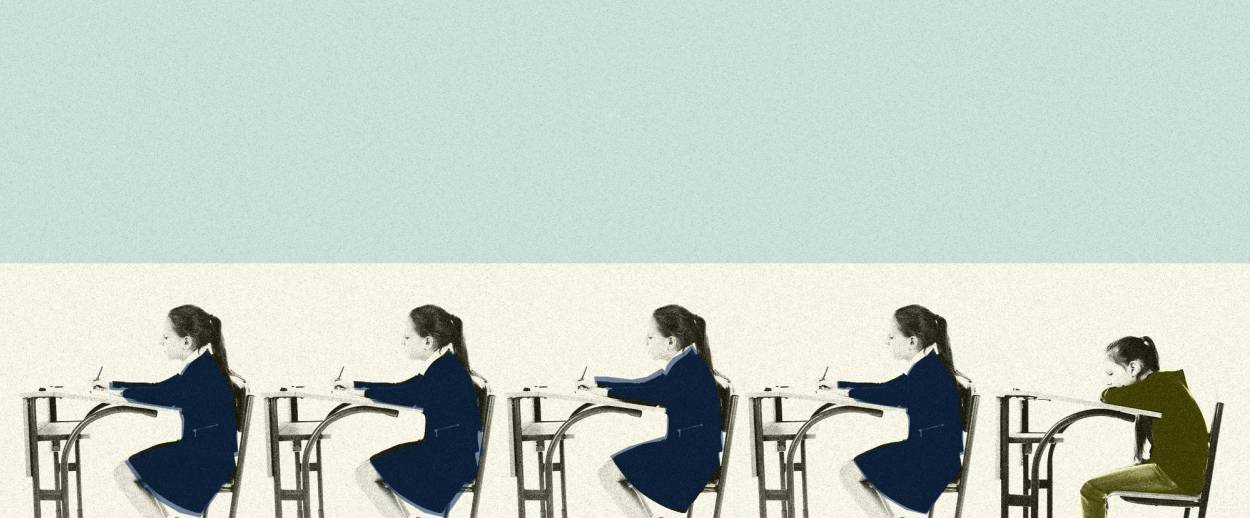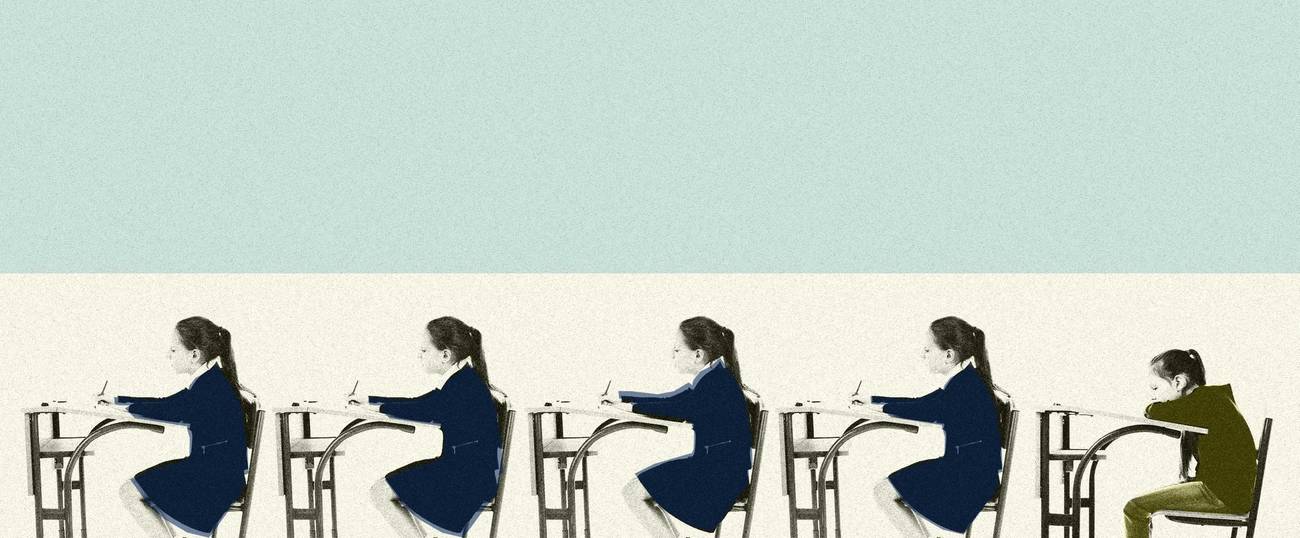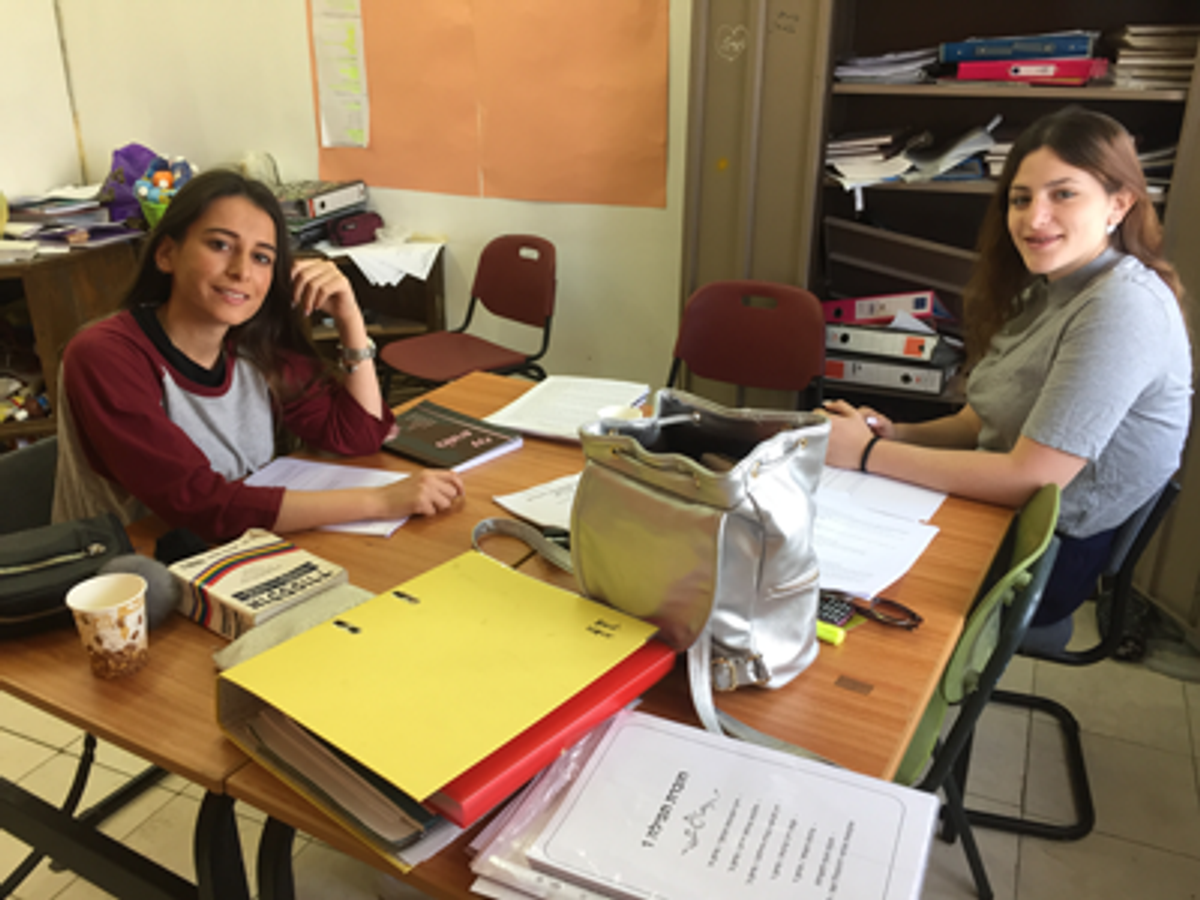What Becomes of Troubled Ultra-Orthodox Kids?
In Israel, a bevy of new programs are helping at-risk youth who’ve long been overlooked




Inside a stone house in Jerusalem’s ultra-Orthodox Romema neighborhood, eight teenage girls were taking a break from their studies to eat lunch. They wore long skirts, typical of the religious homes they come from, with colorful plaid flannel shirts less typical—in fact, not allowed—in most of the schools these girls used to attend. But the shirts are just fine at Neot Tamar, a new school aimed at youth-at-risk in Israel’s ultra-Orthodox sector.
“Before, I used to not want to go to school,” said one girl, 15, who started here a few days earlier, after dropping out of her ultra-Orthodox school. “But here I think I can really finish my studies. They are warm and caring here, and it’s very chill and relaxed.”
At Neot Tamar, which opened May 7, several of the eight girls already enrolled said that they have already formed close bonds with each other and with their teacher, and that they look forward to coming here each day. As they work toward high school diplomas and learn computer skills, they also receive counseling and more individualized attention than they got in their mainstream high schools.
“These are girls who are at the beginning of going downhill, either because of learning issues or problems at home,” said Ester Rozman, Neot Tamar’s director, who in 2008 left her job at an elite ultra-Orthodox school to create alternative educational frameworks. Her goal was to better serve those students who had left the sector’s rigid and traditional systems of learning or had other difficulties, ranging from experiencing abuse to living on the streets. Neot Tamar is the third school opened by Rozman and her husband, who also works with at-risk youth, and is unique in that it caters to teens who are only showing early signs of not fitting into the traditional educational frameworks.

This is just one of a growing number of initiatives, including schools, shelters, and mentoring programs, established in recent years to help at-risk ultra-Orthodox youth. In addition, many existing institutions serving at-risk youth in general have added programs catering to the ultra-Orthodox. The city of Jerusalem has also made the issue a priority, creating in April a new position of a project manager to oversee all programs for youth-at-risk in the sector. Among professionals who work with at-risk youth—which they define as kids who have dropped out of school, come from extreme poverty or unstable homes, or have suffered abuse, thus reducing their chances for a successful transition into adulthood, and increasing their chances for behaviors like drug abuse, criminal activity, entering into unhealthy relationships, or causing other harm to themselves—such challenges have long gone unaddressed in the Haredi community, until these recent changes.
“This population is really getting a lot of attention now, and it is seen as a key issue,” said Sharone April, director of the Jerusalem Innovation Team, a consulting organization funded by U.S.-based Bloomberg Philanthropies, which reports to the mayor’s office. The team uses data-driven approaches to work on projects ranging from youth-at-risk to improving public spaces. An Innovation Team project to track and create more cooperation between the various organizations serving at-risk youth was recently piloted in one ultra-Orthodox neighborhood and will soon start in six others.
“This wouldn’t have been possible even a few years ago,” said Shai Moshe, a licensed social worker and the Innovation Team’s project manager for youth at risk. “But today the community is more open to programs to help youth-at-risk, and there are a growing number of professionals like social workers and psychologists inside the community.”
In the ultra-Orthodox sector, about 8 percent of students drop out of high school, four times the average rate, according to the Central Bureau of Statistics. And dropping out of school is often the first step for teenagers who are labeled as “at-risk.” It can be a precursor to isolation from families and communities, and, in the most extreme cases, living on the streets. But only in the last decade has ultra-Orthodox society, and its separate, state-funded school system, begun to address the dropout issue and the underlying problems that lead to leaving school. “There is, slowly, more acceptance of the need to address these issues now,” said Nicole Dehan, an ultra-Orthodox social worker with a private clinic in Jerusalem. Struggling youth are now more prevalent and more visible, she said.
Rapid population growth, high poverty rates, and social changes within the community—including the penetration of technology like smartphones, and more men going to work or army service instead of engaging in full-time learning—have led to more flux. “It also used to be that youth-at-risk in the ultra-Orthodox sector came mainly from poor families or newly religious families, but now, sadly, we can see that it is happening in all families, even in the best families,” Dehan said.
***
During the decades that Rozman, the new school’s founder, spent teaching at a religious seminary, she found that when girls began flouting the dress code or not showing up, it often correlated with attention deficit disorder or with stress at home. “Not dressing appropriately was only the call for help, the SOS,” Rozman said. “They had real struggles, often inside, and the school had no real way to help them.” Such girls often left or were kicked out, leaving them with no other options.
“And the fall for ultra-Orthodox girls who are not within an educational framework is very steep and very fast,” Rozman said. “Once they do one thing that is not acceptable, it often leads to doing many other things.”
Around the same time, about a decade ago, her husband, Dov, a judge on a Jerusalem religious court, also noticed the high number of ultra-Orthodox boys who, instead of attending yeshiva, spent their days hanging out on the street. “Everyone sees these kids in the streets,” Dov said. “But the Haredi system did not have any solution for them back then. There was nothing for these weaker learners to do.”
So in 2008, the Rozmans, who have nine children, opened one program for boys and one program for girls who had dropped out of the traditional education system. They teamed up with the Amal Educational Network, which operates high schools around Israel with a strong focus on technology, and also offers programs for youth-at-risk, to design the first alternative ultra-Orthodox educational framework. The boys’ school is called Amalenu and combines traditional yeshiva-style learning with technical and vocational skills, as well as offers counseling and life-skills courses. The girls’ school, called Tlamim, also incorporates counseling and operates three dorms to house students who have left home, sometimes by choice and sometimes by court order. Neot Tamar is the couple’s most recent project.
The biggest difference between the boys’ and girls’ programs is that in most cases the boys have left the traditional yeshiva framework, which requires long days of Talmud study, due to learning disabilities. “But the girls, we only see things like learning disabilities in about 40 percent,” Ester Rozman said. “In most cases, they are suffering and end up outside the traditional framework because of bad situations at home.”
That’s how one 18-year-old Jerusalem girl ended up at Tlamim. “What happened at home is really complicated,” the girl said, declining to give details. But two years ago she moved to Tlamim and finally found herself feeling secure enough to focus on her studies. “This is a very warm place, and here I have figured out that if I make the investment, I can do anything and go anywhere,” said the girl. “Before this, I never did anything.” On the day she spoke with me, she was one of only two girls in Tlamim’s school building, near the Central Bus Station. There were no classes due to the Lag BaOmer holiday, but this particular girl had come in to spend extra time studying for a final exam in Hebrew language and grammar.
“Let’s just say that I was in a very difficult place when I came here,” she said. “And even though I still don’t know exactly what I want to do, at least now I understand myself better.”
***
In addition to the increasing number of programs within the ultra-Orthodox sector, many institutions for the general population are catering to more and more ultra-Orthodox.
On an upper floor of a building in downtown Jerusalem, in the main room of Hut HaMeshulash, a daytime shelter for youth in Jerusalem, three teenage boys lounged on sofas. Two were looking at their phones, and the third was rolling a cigarette. A table held two pots of lentil soup and a box of bread—the day’s lunch for the dozens of youth who were here because they had nowhere else to go.
In addition to providing three meals a day, showers, therapy services, and vocational training, Hut HaMeshulash contains all the trappings of a religious Jewish home: mezuzahs on the doorways, washing cups by the sinks, a shelf full of sefarim (religious books), and a large portrait of Menachem M. Schneerson, the late Lubavitcher Rebbe. (Although not Lubavitchers, the founders admire the Chabad movement.) On holidays and Shabbat, there are catered meals at a large communal table.
“In recent years, we have seen more youth coming here from ultra-Orthodox homes, and they are now about 80 percent of who we serve,” said Dana Goldstein, who founded Hut HaMeshulash 18 years ago with her husband and with the support of the Ministry of Welfare. Most youth who end up at Hut HaMeshulash no longer live a religious lifestyle, she said, but they still derive comfort from Shabbat meals—even if eaten by teens with smartphones in their pockets—and the presence of holy books, even if they rarely look at them.
“They can be here what they want, who they want, but many are used to a Jewish home environment, so that is what we provide,” Goldstein said. “Most who have left the religious lifestyle, it is not a philosophical decision, but because they didn’t fit into the system, and they can’t just ignore that. They can’t cancel themselves.”
While programs serving Jerusalem’s at-risk ultra-Orthodox are spreading, not everyone who needs help is getting it. A recent mapping project carried out by the Bloomberg Innovation Team found 70 initiatives or individuals, including social workers, nonprofit workers, and rabbis, focused on this issue in the ultra-Orthodox Bukhari neighborhood alone. But many of the organizations didn’t know about each other, let alone work together. Their lack of coordination with each other has caused many children to be overlooked over the years, said Eran Schimmel, a social worker and manager of a community center for youth-at-risk. Now everyone involved in the issue is part of a so-called roundtable that meets regularly, and will eventually keep track of which youth are using which services, and whether their needs are being met.
“Until now, there was no order,” Schimmel said. “Now, everyone needs to cancel their ego, and we are all working together. It really is a gift.”
Back in the Romema neighborhood, the new Neot Tamar school is large enough to eventually enroll 30 girls. Ester Rozman said she started this additional facility, in a rented house surrounded by overgrown gardens that the students will eventually clean up and tend, to provide a place for girls who are only showing early signs of risky behavior. She didn’t want these girls, who still live at home, to be exposed to the more serious issues, including drug and alcohol abuse, suffered by students in Tlamim.
“I don’t want them to come somewhere for help and then be exposed to more negative things,” Rozman said. “But hopefully here they will find themselves so that they can succeed in life, and that takes more than just a high school certificate. It takes a lot of inner work and love.”
***
Like this article? Sign up for our Daily Digest to get Tablet Magazine’s new content in your inbox each morning.
Sara Toth Stub is a Jerusalem-based American journalist who has written for The Wall Street Journal, Dow Jones Newswires, Associated Press, and other publications.